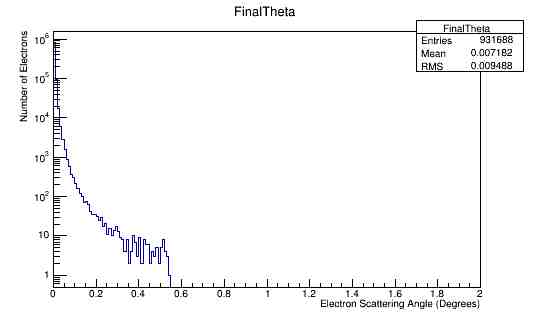Difference between revisions of "Looking at effects of Solenoid on Phi Shifts"
| Line 1: | Line 1: | ||
=[[Using Moller Data to alter energy range]]= | =[[Using Moller Data to alter energy range]]= | ||
| − | Using the Moller event file MollerScattering_NH3_4e8incident.dat, we can use the fact that GEMC will only create a particle based on the Moller electron. While the data for the scattered electron is passed within a LUND file, kinematically this electron doesn't leave the beam area, and thus never enters the detectors to be recreated. | + | Using the Moller event file MollerScattering_NH3_4e8incident.dat, we can use the fact that GEMC will only create a particle based on the Moller electron. While the data for the scattered electron is passed within a LUND file, kinematically this electron doesn't leave the beam area, and thus never enters the detectors to be recreated. Since the solenoid's purpose is draw electrons trajectories closer the the beam line any electron close the the beam line will be drawn even closer, ensuring that it is never recreated in a GEMC simulation. |
| + | |||
| + | We can alter the energy conversion from MollerScattering_NH3_4e8incident.dat to investigate the energy-phi shift relationship | ||
<center>[[File:FinalTheta.jpg]]</center> | <center>[[File:FinalTheta.jpg]]</center> | ||
| Line 15: | Line 17: | ||
ke=evt.MolKE/1000; | ke=evt.MolKE/1000; | ||
</pre> | </pre> | ||
| + | Using the fact that the minimum momentum of MollerScattering_NH3_4e8incident.dat | ||
| + | |||
| + | <pre> | ||
| + | awk 'NR == 1 {line = $0; min = $15} NR >1 && $15 < min {line =$0; min =$15} END{print line}' MollerScattering_NH3_4e8incident.dat | ||
| + | |||
| + | 11000 0 0 11000.5 0 0 0 10997.9 1.42548 -0.177032 10998.4 0 0 0 2.01929 -1.42548 0.177032 2.01939 0 0 -509.621 </pre> | ||
| + | |||
| + | Dividing by 1 will give us a distribution of | ||
=[[Solenoid_effect_in_ 2_GeV_and_up_range|Solenoid effect > 2GeV]]= | =[[Solenoid_effect_in_ 2_GeV_and_up_range|Solenoid effect > 2GeV]]= | ||
Revision as of 21:09, 5 April 2016
Using Moller Data to alter energy range
Using the Moller event file MollerScattering_NH3_4e8incident.dat, we can use the fact that GEMC will only create a particle based on the Moller electron. While the data for the scattered electron is passed within a LUND file, kinematically this electron doesn't leave the beam area, and thus never enters the detectors to be recreated. Since the solenoid's purpose is draw electrons trajectories closer the the beam line any electron close the the beam line will be drawn even closer, ensuring that it is never recreated in a GEMC simulation.
We can alter the energy conversion from MollerScattering_NH3_4e8incident.dat to investigate the energy-phi shift relationship

Px=evt.FnlMom[0]/1000;
Py=evt.FnlMom[1]/1000;
Pz=evt.FnlMom[2]/1000;
px=evt.MolMom[0]/1000;
py=evt.MolMom[1]/1000;
pz=evt.MolMom[2]/1000;
KE=evt.FnlKE/1000;
ke=evt.MolKE/1000;
Using the fact that the minimum momentum of MollerScattering_NH3_4e8incident.dat
awk 'NR == 1 {line = $0; min = $15} NR >1 && $15 < min {line =$0; min =$15} END{print line}' MollerScattering_NH3_4e8incident.dat
11000 0 0 11000.5 0 0 0 10997.9 1.42548 -0.177032 10998.4 0 0 0 2.01929 -1.42548 0.177032 2.01939 0 0 -509.621
Dividing by 1 will give us a distribution of